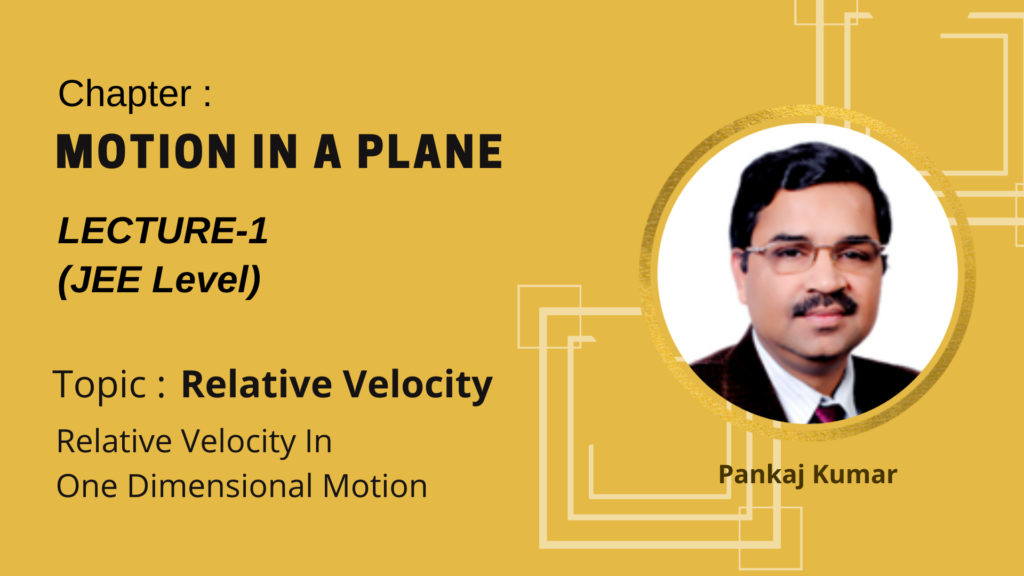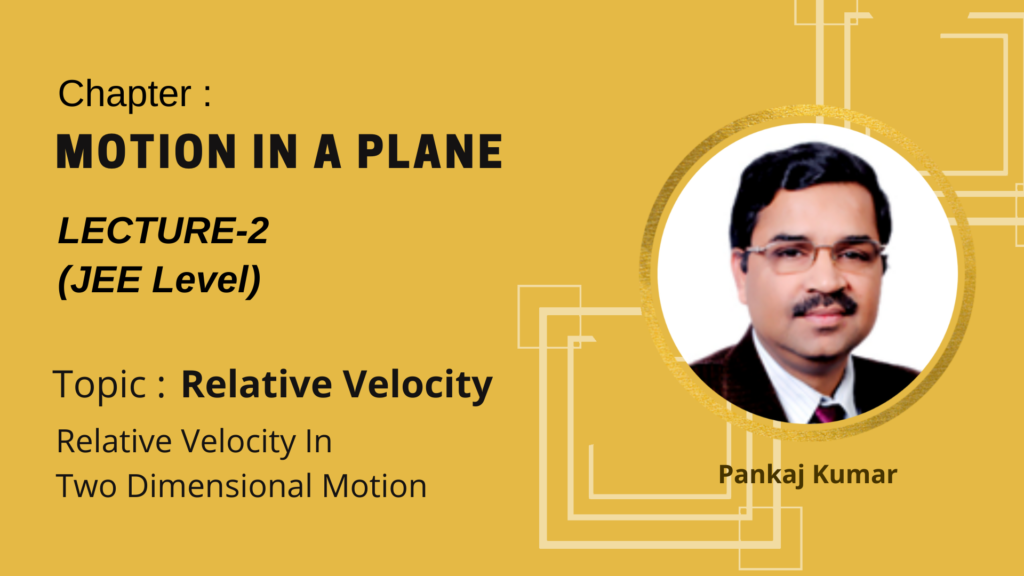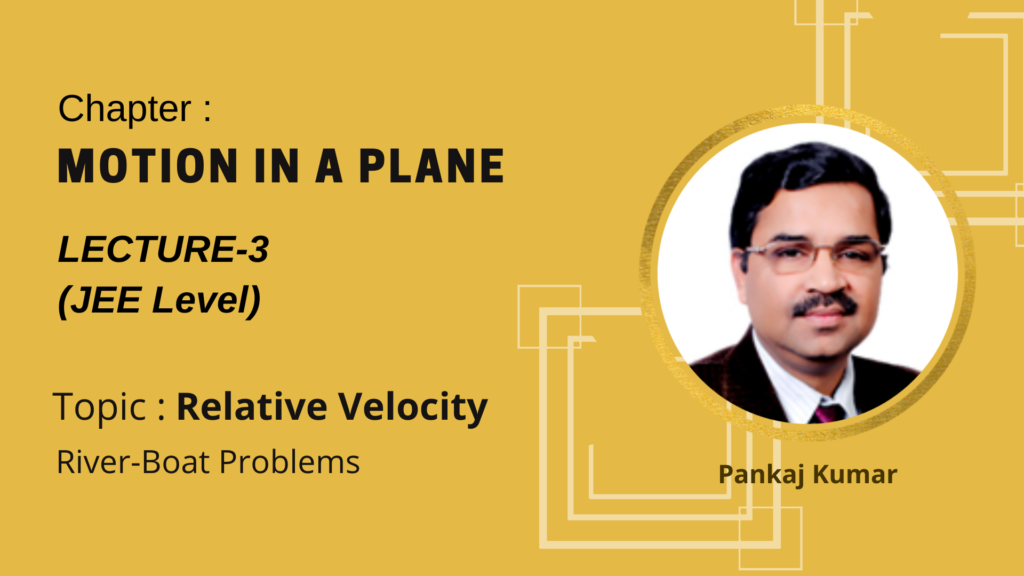Video Lecture
Theory For Making Notes
Relative Velocity In One Dimension
Every motion is relative as it has to be observed with respect to an observer. Relative velocity is a measurement of velocity of an object with respect to other observer. It is defined as the rate of change of relative position of one object w.r.t. to another with time
If an object A is moving with velocity vector \displaystyle {{\vec{v}}_{{AG}}} ( velocity Of A with respect to ground ) and an object B with velocity \displaystyle {{\vec{v}}_{{BG}}} ( velocity Of B with respect to ground ), then the velocity of object A relative to object B is given as
\displaystyle {{\vec{v}}_{{AB}}}={{\vec{v}}_{AG}}-{{\vec{v}}_{BG}}
This can also be written simply as \displaystyle {{\vec{v}}_{{AB}}}={{\vec{v}}_{A}}-{{\vec{v}}_{B}}
The relative velocity of object B relative to object A is
\displaystyle {{\vec{v}}_{{BA}}}={{\vec{v}}_{B}}-{{\vec{v}}_{A}}
Where,
\displaystyle {{v}_{{AG}}}\,=relative velocity of A with respect to ground.
\displaystyle {{v}_{{BG}}}\,=relative velocity of B with respect to ground.
\displaystyle {{v}_{{AG}}}\, and \displaystyle {{v}_{{BG}}}\, could be written as \displaystyle {{v}_{A}}\, and \displaystyle {{v}_{B}}\, respectively.
Now, we will discuss different cases of relative velocity.
Case I :
If the two bodies A and B move with the same speed in the same direction i.e. \displaystyle {{v}_{B}}={{v}_{A}},\,hence\,{{v}_{B}}-{{v}_{A}}=0, then the objects appears at rest with respect to each other in other words then the two objects A and B stay at a constant distance from each other. In this case their position-time graphs are parallel to each other. Thus, the relative velocity \displaystyle {{v}_{{AB}}} or \displaystyle {{v}_{{BA}}} is zero.
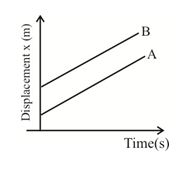
Case –II :
If \displaystyle {{v}_{A}}>{{v}_{B}},\,then\,{{v}_{B}}-{{v}_{A}} is negative, then the position time graph of A is steeper than that of B, and they meet at a common point where they are at the same position.
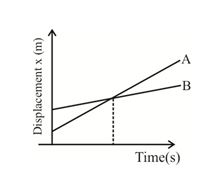
Case-III :
If \displaystyle {{v}_{A}} and \displaystyle {{v}_{B}} are in opposite direction hence of opposite signs, then the relative velocity of A with respect to B is \displaystyle {{\vec{v}}_{{AB}}}={{\vec{v}}_{A}}+{{\vec{v}}_{B}} . For example if the objects under consideration are two trains, then for a person sitting in one train, the other trans seem to go very fast.
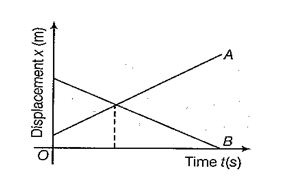
Illustration
Two trains A and B of length 400m each are moving on two parallel tracks with a uniform speed of 72 \displaystyle km\,{{h}^{{-1}}} in the same direction with A ahead of B. The driver of B decides to overtake A and accelerates by 1 \displaystyle m{{s}^{{-2}}}. If after 50 s, the guard of B just brushes past the driver of A, what was the original distance between them ?
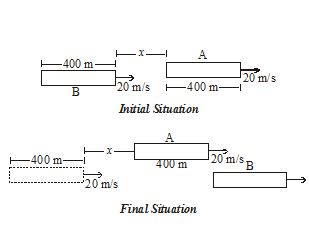
Solution
Let x = initial distance b/w A & B and A is ahead of B. When B just passes A the distance travelled by B with respect to A is = \displaystyle x+800\,
\displaystyle \therefore \,\,\,\,\,{{S}_{{B,A}}}\,\,=\,\,x+800
the initial relative veloity of B w.r.t. A is given by \displaystyle {{u}_{{B,\,A}}}\,\,=\,0
the relative acceleration of B w.r.t. A is given by \displaystyle {{a}_{{B,A}}}\,\,=\,\,1\,\,m/{{s}^{2}}
and it is given that \displaystyle t\,=\,50\,\,\sec
Hence applying \displaystyle {{S}_{{B,\,\,A}}}\,=\,{{u}_{{BA}}}t\,+\,\frac{1}{2}{{a}_{{B,A}}}{{t}^{2}}
\displaystyle x\,+\,800\,=\,0+\frac{1}{2}\times \,1\,\,\times \,\,{{50}^{2}}
\displaystyle \therefore \,\,\,x\,=\,450\,\,m
Illustration
Two towns A and B are connected by a regular bus service with a bus leaving in either direction at a interval of t min. A man cycling with a speed of 20 km/h in the direction A to B notices that a bus goes past him every 18 min in the direction of his motion and every 6 min in the opposite direction. What is the period T of the bus service and with what speed (assumed constant) do the busses ply on the road ?
Solution
Let v km/h be the constant speed with which the busses plying between the towns A and B. The relative velocity of the bus (for the motion A to B) with respect to the cyclist (i.e., in the direction in which the cyclist is going = ( \displaystyle v-20) \displaystyle km{{h}^{{-1}}}. The relative velocity of the bus from B to A with respect to the cyclist ( \displaystyle v+20) km/h.
The distance travelled by the bus in time T (minutes) = vT
As per question,
\displaystyle \frac{{vT}}{{v-20}}\,=\,18\,\,or\,\,vT\,\,=\,\,18v\,\,-\,18\,\times \,20 …(i)
and \displaystyle \frac{{vT}}{{v-20}}\,=\,6\,\,or\,\,vT\,\,=\,\,6v\,\,+\,20\,\times \,6 ….(ii)
By Eqs. (i) and (ii), we get
\displaystyle 18v\,-\,18\,\times \,20\,\,=\,6v\,\,+\,20\,\,\times \,\,6
Or \displaystyle 12v\,=20\,\times \,6\,\,+\,18\,\,\times \,\,20\,=\,480
Or \displaystyle v\,=\,40\,\,km/h
Putting this value of v in Eq. (i), we get
\displaystyle 40T\,\,=\,\,18\,\,\times \,\,40-18\times \,\,20
= \displaystyle 18\,\,\times \,\,20
Or \displaystyle T\,=\,18\,\times \,\,20/40\,\,=\,9\,\,\min
Illustration
From a lift moving upward with a uniform acceleration ‘a’, a man throws a ball vertically upwards with a velocity v relative to the lift. The ball comes back to the man after a time t. Show that a + g = 2 v/t.
Solution:
Let us consider all the motion from lift frame. Then, the acceleration, displacement and velocity everything will be considered from the lift frame itself.
As the ball comes again to the man, therefore displacement from the lift frame is zero.
Again, the velocity with respect to the lift frame is v.
Similarly, the acceleration with respect the lift frame is
g – (–a) = a + g (downwards)
Now, s = ut + \displaystyle \frac{1}{2}at2
0 = vt – \displaystyle \frac{1}{2} (a+g)t2
or a + g = 2 \displaystyle \frac{v}{t}.
RELATIVE VELOCITY IN TWO DIMENSIONAL MOTION
All the motion studied till now is defined with respect to a reference point of a coordinate system i.e. origin O, which is assumed to be at rest. The motion of any object, say A, w.r.t. any other moving object, say B, is termed as relative motion of object A with respect to object B.
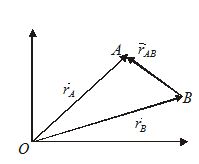
In figure the position vector of A with respect to B can be given as {{\vec{r}}_{{AB}}}={{\vec{r}}_{A}}-{{\vec{r}}_{B}}
Differentiating this equation, we get
\frac{{d{{{\vec{r}}}_{{AB}}}}}{{dt}}=\frac{{d{{{\vec{r}}}_{A}}}}{{dt}}-\frac{{d{{{\vec{r}}}_{B}}}}{{dt}}
or {{\vec{v}}_{{AB}}}={{\vec{v}}_{A}}-{{\vec{v}}_{B}}
Here {{\vec{v}}_{A}} and {{\vec{v}}_{B}} are the velocities of A and B, respectively, with respect to O and {{\vec{v}}_{{AB}}} is the velocity of A w.r.t. B
Differentiating again, we get
\frac{{d{{{\vec{v}}}_{{AB}}}}}{{dt}}=\frac{{d{{{\vec{v}}}_{A}}}}{{dt}}-\frac{{{{{\vec{v}}}_{B}}}}{{dt}}
or \displaystyle \overset{\to }{\mathop{{{{a}_{{AB}}}}}}\,=\overset{\to }{\mathop{{{{a}_{A}}}}}\,-\overset{\to }{\mathop{{{{a}_{B}}}}}\,
(i)
If an object move with uniform relative acceleration, then equations of motions are modified as
\overset{\to }{\mathop{{{{v}_{{rel}}}}}}\,=\overset{\to }{\mathop{{{{u}_{{rel}}}}}}\,+\overset{\to }{\mathop{{{{a}_{{rel}}}}}}\,t
\overset{\to }{\mathop{{{{s}_{{rel}}}}}}\,=\overset{\to }{\mathop{{{{u}_{{rel}}}}}}\,+\frac{1}{2}\overset{\to }{\mathop{{{{a}_{{rel}}}}}}\,{{t}^{2}}
{{v}_{{rel}}}^{2}-{{u}_{{rel}}}^{2}=2\overset{\to }{\mathop{{{{a}_{{rel}}}}}}\,.\overset{\to }{\mathop{{{{s}_{{rel}}}}}}\,
Rain–Man problem
For a man in motion the rain appears to fall with a velocity other than the actual velocity of the rain. The actual velocity of the rain means the velocity of rain that appears to a stationary man or the velocity of the rain with respect to the stationary ground
If the rain is falling down with a velocity {{\vec{v}}_{{rain}}} and the man is moving on ground with velocity {{\vec{v}}_{{man}}}, then the relative velocity of rain w.r.t. man {{\vec{v}}_{{rel}}} appear different from {{\vec{v}}_{{rain}}}.
Always remember that what the man see is the relative velocity of the rain with respect to himself.
There can be different cases where the direction of rain can be changed as given below
Case-I:
When rain is falling down vertically

While applying triangle law here always remember that the velocity of man should be taken opposite to the actual velocity of man. For example in the diagram givwn above the man must be moving rightward but its velocity vector is taken leftward in the triangle law.
As explain above, the relative velocity of rain with respect to man is given as
{{\vec{v}}_{{rel}}}={{\vec{v}}_{{rain}}}-{{\vec{v}}_{{man}}} ={{\vec{v}}_{{rain}}}+(-{{\vec{v}}_{{man}}})
This equation is represented in figure and it suggest that the magnitude of \displaystyle {{\vec{v}}_{{rel}}} is given by
{{{v}}_{{rel}}}=\sqrt{{{{v}_{{rain}}}^{2}+{{v}_{{man}}}^{2}}}
The rain appear to man falling down from the front making an angle with vertical given as
\theta ={{\tan }^{{-1}}}\left( {\frac{{{{v}_{{man}}}}}{{{{v}_{{rain}}}}}} \right)
Case- II:
When rain is falling from the front making an angle \displaystyle \phi with vertical
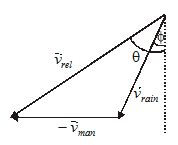
The situation is shown in figure and it suggest that
{{v}_{{rel}}}=\sqrt{{{{{({{v}_{{rain}}}\cos \phi )}}^{2}}+{{{({{v}_{{rain}}}\sin \phi +{{v}_{{man}}})}}^{2}}}}
=\sqrt{{{{v}_{{man}}}^{2}+{{v}_{{rain}}}^{2}+2{{v}_{{man}}}{{v}_{{rain}}}\sin \phi }}
and
\theta ={{\tan }^{{-1}}}\left( {\frac{{{{v}_{{man}}}+{{v}_{{rain}}}\sin \phi}}{{{{v}_{{rain}}}\cos \phi }}} \right)
Note that the angle of rain appear to be more with the verticle than actual i.e. q > f in simple words the rain appear to be more horizontal than it appear to a person at rest.
Case-III:
When rain is falling from the backside at angle \phi with vertical
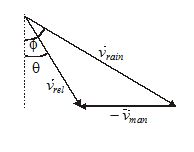
The situation, as shown in figure, suggest that
{{v}_{{rel}}}=\sqrt{{{{{({{v}_{{rain}}}\cos \phi )}}^{2}}+{{{({{v}_{{rain}}}\sin \phi -{{v}_{{man}}})}}^{2}}}}
=\sqrt{{{{v}_{{rain}}}^{2}+{{v}_{{man}}}^{2}-2{{v}_{{rain}}}{{v}_{{man}}}\sin \phi }}
and
\theta ={{\tan }^{{-1}}}\left( {\frac{{{{v}_{{rain}}}\sin \phi -{{v}_{{man}}}}}{{{{v}_{{rain}}}\cos \phi }}} \right)
In this case:
- If {{v}_{{man}}}<{{v}_{{rain}}}\sin \phi , then rain appears to fall on back.
- If {{v}_{{man}}}={{v}_{{rain}}}\sin \phi , then rain appears to fall vertically.
- If {{v}_{{man}}}>{{v}_{{rain}}}\sin \phi , then rain appears to fall from front.
Illustration
During a rainstorm the raindrops are observed to striking ground at an angle of 37° with the vertical. The wind speed is 4.5 m/s. Assuming that the horizontal velocity component of the raindrops is same as the speed of air, what is the vertical component of velocity of raindrops? What is their speed?
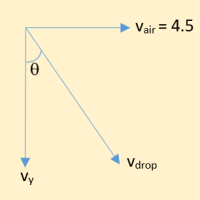
Let v= velocity of raindrops relative to earth and {{v}_{w}} wind velocity.
Then {{v}_{x}}={{v}_{w}}. = 4.5 m/s
From figure
{{v}_{y}}=\frac{{{{v}_{w}}}}{{\tan 37{}^\circ }}=6.0\,\,\mathbf{m/s} and v=\sqrt{{{{v}_{x}}^{2}+{{v}_{y}}^{2}}}=7.5\,\,\mathbf{m/s}
Illustration
A man standing on a road has to hold his umbrella at 30° with the vertical to keep the rain away. He throws the umbrella and starts running at 10 km/h. He finds that raindrops are hitting his head vertically. Find the speed of raindrops with respect to (a) the road, (b) the moving man runs is shown in the figure (b)
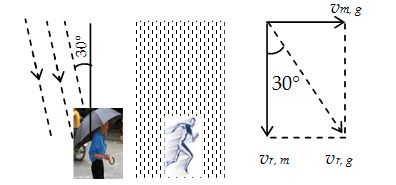
Here \displaystyle {{\overrightarrow{{v\,}}}_{{r,g}}}=velocity of the rain with respect to the ground
\displaystyle {{\overrightarrow{{v\,}}}_{{m,g}}}=velocity of the man with respect to the ground and
\displaystyle {{\overrightarrow{{v\,}}}_{{r,m}}}= velocity of the rain with respect to the man.
We have, \displaystyle {{\overrightarrow{{v\,}}}_{{r,g}}}={{\overrightarrow{{v\,}}}_{{r,m}}}+{{\overrightarrow{{v\,}}}_{{m,g}}} … (1)
Taking horizontal components, equation (1) gives
\displaystyle {{v}_{{r,g}}}\sin 30{}^\circ ={{v}_{{m,g}}}=10km/h
or \displaystyle {{v}_{{r,g}}}=\frac{{10\,\text{km/h}}}{{\sin 30{}^\circ }}=20\text{km/h}
Taking vertical components, equation (1) gives
\displaystyle {{v}_{{r,g}}}\cos 30{}^\circ ={{v}_{{r,\,\,m}}}
or \displaystyle {{v}_{{r,m}}}=(20\text{km/h})\frac{{\sqrt{3}}}{2}
= \displaystyle 10\sqrt{3} km/h
Illustratuion
Three particles A, B and C are situated at the vertices of an equilateral triangle ABC of side d at t = 0. Each of the particles moves with constant speed v. A always has its velocity along AB, B along BC and C along CA. At what time will the particles meet each other?
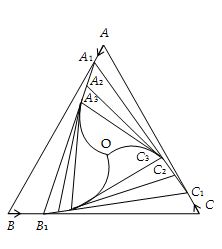
Solution
The motion of the particles is roughly sketched in figure. By symmetry they will meet at the centroid O of the triangle . At any instant the particles will form an equilateral triangle ABC with the same centriod O. Concentrate on the motion of any one particle, say A. At any instant its velocity makes angle 30° with AO.
The component of this velocity along AO is v cos 30°. This component is the rate of decrease of the distance AO. Initially,
\displaystyle AO=\frac{2}{3}\sqrt{{{{d}^{2}}-{{{\left( {\frac{d}{2}} \right)}}^{2}}}}=\frac{d}{{\sqrt{3}}}.
Therefore, the time taken for AO to become zero
\displaystyle =\frac{{d/\sqrt{3}}}{{v\cos 30{}^\circ }}=\frac{{2d}}{{\sqrt{3}v\times \sqrt{3}}}=\frac{{2d}}{{3v}}.
Alternative: Velocity of A is v along AB. The velocity of B is along BC. Its component along BA is v cos 60° = v/2. Thus, the separation AB decreases at the rate
\displaystyle v+\frac{v}{2}=\frac{{3v}}{2}.
Since this rate is constant, the time taken in reducing the separation AB from d to zero is
\displaystyle t=\frac{d}{{\frac{{3v}}{2}}}=\frac{{2d}}{{3v}}.
Illustration
A man walking eastward at 5m/s observes that wind is blowing from the north. On doubling his speed eastward, he observes that wind is blowing from north-east. Find the velocity of the wind
Solution
First of all lets take west to east as +x axis and north to south as -y axis.
Now let velocity of the wind be
= \displaystyle {{\vec{v}}_{w}}={{v}_{1}}\hat{i}+{{v}_{2}}\hat{j}m/s
And velocity of the man is
\displaystyle {{\vec{v}}_{m}}=5\hat{i}
{{\vec{v}}_{{wm}}}={{\vec{v}}_{w}}-{{\vec{v}}_{m}}= \displaystyle \left( {{{v}_{1}}-5} \right)\hat{i}+{{v}_{2}}\hat{j}
In first case,
v1– 5 = 0
( because the relative velocity is directed from north hence all velocity is along y axis and therefore the x component of relative velocity is zero)
v1 = 5 m/s.
In the second case,
{{\vec{v}}_{{wm}}}={{\vec{v}}_{w}}-{{\vec{v}}_{m}}= \displaystyle \left( {{{v}_{1}}-10} \right)\hat{i}+{{v}_{2}}\hat{j}
tan45° = \displaystyle \frac{{{{v}_{2}}}}{{{{v}_{1}}-10}}
v2 = v1– 10 = -5 m/s.
\displaystyle {{\vec{v}}_{w}}=5\hat{i}-5\hat{j}m/s
River–Boat Problem
Consider a boat that can move in still water with velocity {{\vec{u}}_{{boat}}}. If a river is flowing with stream of velocity {{\vec{v}}_{{stream}}}, and the boat is moving in the stream with full throttle then the resultant velocity ( {{\vec{v}}_{{boat}}}) of the boat in the water stream is given by the vector sum of {{\vec{v}}_{{stream}}} and {{\vec{u}}_{{boat}}}.
{{\vec{v}}_{{boat}}}={{\vec{v}}_{{stream}}}+{{\vec{u}}_{{boat}}}
Case-I:
Motion of boat up the stream
When boat move against stream, its speed w.r.t. ground decreases i.e., {{v}_{{boat}}}={{u}_{{boat}}}-{{v}_{{stream}}}

Thus boat will reach its destination if {{u}_{{boat}}}>{{v}_{{stream}}} and it will take time more than required in still water.
Case-II:
Motion of boat down the stream
In this case, stream add its velocity to the boat and hence w.r.t. ground, the speed of boat increases.
{{v}_{{boat}}}={{u}_{{boat}}}+{{v}_{{stream}}}
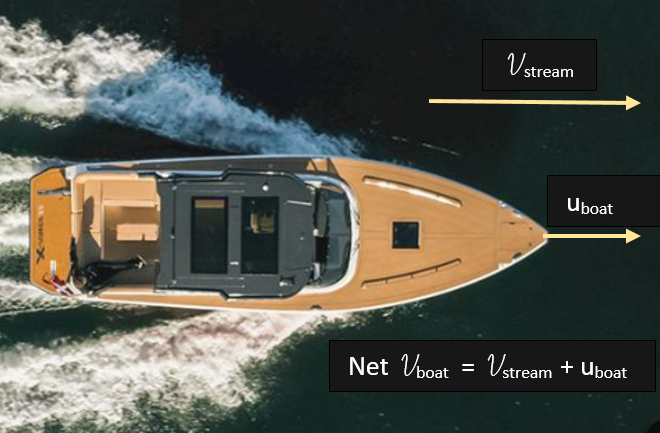
Thus, boat reaches its destination point in lesser time.
Case-III:
Motion of boat perpendicular to the stream
When boat move perpendicular to stream, then its actual direction of motion make some angle with stream and it never reaches a point directly opposite on other bank of river as shown in figure
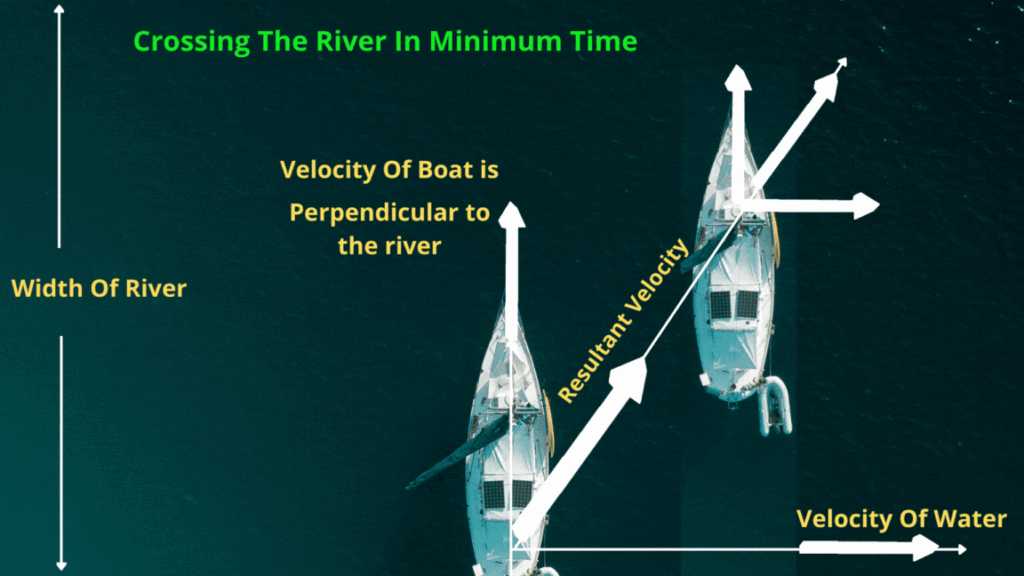
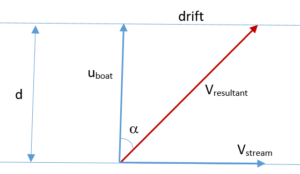
The speed of boat w.r.t. ground is {{v}_{{boat}}}=\sqrt{{{{v}_{{stream}}}^{2}+{{u}_{{boat}}}^{2}}}
and it move in a direction making an angle with stream
\varphi =\frac{\pi }{2}-\alpha =\frac{\pi }{2}-{{\tan }^{{-1}}}\left( {\frac{{{{v}_{{stream}}}}}{{{{u}_{{boat}}}}}} \right)
Time required for crossing the river t=\frac{d}{{{{u}_{{boat}}}}} and drift along the stream {{x}_{{drift}}}={{v}_{{stream}}}t=\frac{{{{v}_{{stream}}}}}{{{{u}_{{boat}}}}}d
Note that this is the minimum time taken by boat to cross-river
Case-IV
Motion of boat for minimum drift,
If the boat has to reach directly opposite to the initial point on the other bank the boat has to move at angle \frac{\pi }{2}+\alpha with stream shown in figure
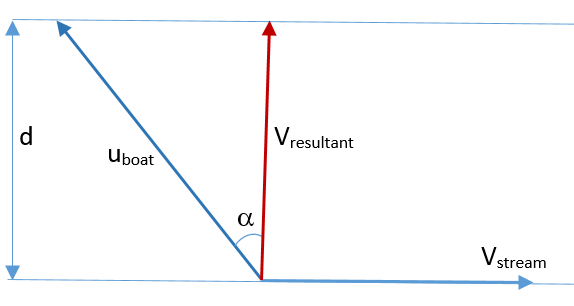
The speed of boat w.r.t. ground is {{v}_{{boat}}}=\sqrt{{{{u}_{{boat}}}^{2}-{{v}_{{stream}}}^{2}}}and it move in a direction making an angle with stream given as \varphi =\frac{\pi }{2}+{{\sin }^{{-1}}}\left( {\frac{{{{v}_{{stream}}}}}{{{{u}_{{boat}}}}}} \right)
Case – V
A man cross the river and then walks on the shore to reach the point directly opposite to his initial point.
To attain the direct opposite point B in the minimum time. Let the man swim at an angle q with the direction AB. The total time of journey t = the time taken from A to C and the time taken from C to B
t = tAC + tCB
where tAC = \displaystyle \frac{{AB}}{{{{v}_{{man}}}\cos \theta }} & {{t}_{{CB}}}\text{ }=\text{ }\frac{{\text{BC}}}{\text{V}} where V = walking speed of the man from C to B.
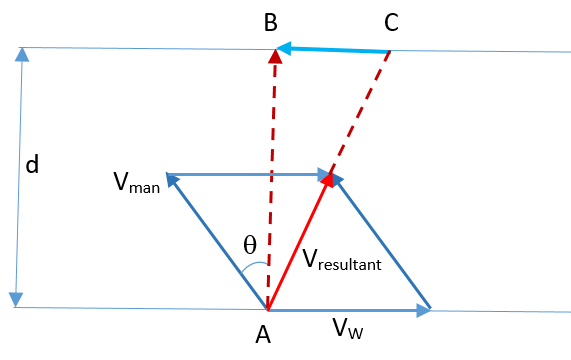
\displaystyle t=\frac{{\text{AB}}}{{{{\text{v}}_{{\text{man}}}}\text{ cos}\theta }}+\frac{{\text{BC}}}{\text{V}}
Again BC = (vresultant)x X t
\displaystyle BC=\text{(}{{\text{v}}_{\text{w}}}-{{\text{v}}_{{\text{man}}}}\text{sin}\theta \text{)}\left( {\frac{{\text{AB}}}{{{{\text{v}}_{{\text{man}}}}\text{cos}\theta }}} \right) , on putting this expression of BC in time t we get
\displaystyle t=\frac{{\text{AB}}}{{{{\text{v}}_{{\text{man}}}}\text{cos}\theta }}+\frac{{\text{(}{{\text{v}}_{\text{w}}}-\text{ }{{\text{v}}_{{\text{man}}}}\text{sin}\theta \text{) AB}}}{{\text{V(}{{\text{v}}_{{\text{man}}}}\text{ cos}\theta \text{)}}}
\displaystyle t\text{ }=\text{ AB }\left[ {\left( {1+\frac{{{{v}_{w}}}}{V}} \right)\frac{{\sec \theta }}{{{{v}_{{man}}}}}-\frac{{\tan \theta }}{V}} \right]
\displaystyle t=\text{d}\left[ {\left( {1+\frac{{{{v}_{w}}}}{V}} \right)\frac{{\sec \theta }}{{{{v}_{{man}}}}}-\frac{{\tan \theta }}{V}} \right]
putting \frac{{dt}}{{d\theta }}\text{ }=\text{ }0, For minimum t we get
\displaystyle \frac{{dt}}{{d\theta }}=\frac{d}{{d\theta }}\left[ {d\left( {\text{1}+\frac{{{{\text{v}}_{\text{w}}}}}{\text{V}}} \right)\frac{{\text{sec}\theta }}{{{{\text{v}}_{{\text{man}}}}}}-\frac{{\text{tan}\theta }}{\text{V}}} \right]
\displaystyle =\left[ {\frac{{\sec \theta \text{ tan}\,\theta }}{{{{v}_{{man}}}}}\left( {\text{1}+\frac{{{{\text{v}}_{\text{w}}}}}{\text{V}}} \right)-\frac{{\text{se}{{\text{c}}^{\text{2}}}\theta }}{\text{V}}} \right]=0
\displaystyle \frac{{\text{tan}\,\theta }}{{{{v}_{{man}}}}}\left( {\text{1}+\frac{{{{\text{v}}_{\text{w}}}}}{\text{V}}} \right)=\frac{{\text{sec}\,\theta }}{\text{V}}
sinθ \displaystyle =\left( {\frac{{{{\text{v}}_{{\text{man}}}}}}{{\text{V}+{{\text{v}}_{\text{w}}}}}} \right)
\displaystyle \theta =\text{si}{{\text{n}}^{{\text{-1}}}}\left( {\frac{{{{\text{v}}_{{\text{man}}}}}}{{\text{V}+{{\text{v}}_{w}}}}} \right).
This expression is obviously true when vman < V + vw.
Practice Questions (Basic Level)
1.
Two cars get closer by 8 m every second while traveling in the opposite directions. They get closer by 0.8 m while traveling in the same directions. What are the speeds of the two cars?
(a) 4 m/s and 4.4 m/s
(b) 4.4 m/s and 3.6 m/s
(c) 4 m/s and 3.6 m/s
(d) 4 m/s and 3 m/s
Ans (b)
2.
A river is flowing from east to west at a speed of 5 m/min. A man on south bank of river, capable of swimming 10 m/min in still water, wants to swim across the river in shortest time, then he should swim
(a) due north
(b) due north-east
(c) due north-east with double the speed of river
(d) due north-west
Ans (a)
3.
The speed of a boat is 5 km/h in still water. It crosses is river of width 1.0 km along the shortest path in 15 minutes, the velocity of the river water (in km/h)
(a) 5
(b) 1
(c) 3
(d) 4
Ans(c)
4.
In previous question, the angle by which the boat should be rowed with the stream is
(a) 37°
(b) 53°
(c) 90°
(d) 127°
Ans (d)
Practice Questions (JEE Main Level)
1.
A large number of particles are moving towards each other with velocity of magnitude having directions of motion randomly distributed. What is the magnitude of average relative velocity between any two particles averaged over all the pairs?
(a) \frac{{4v}}{\pi } (b) 4\pi v (c) v (d) \pi v/4
Ans (a)
2.
The velocity of a swimmer with respect to the ground is u. In what direction w.r.t. the stream should the swimmer swim in order to reach a point just in front of the starting point, if is the speed of river flow
(a) \frac{\pi }{2}+{{\sin }^{{-1}}}\left( {\frac{u}{{\sqrt{{{{u}^{2}}+{{v}^{2}}}}}}} \right) (b) \frac{\pi }{2}+{{\sin }^{{-1}}}\left( {\frac{v}{{\sqrt{{{{u}^{2}}+{{v}^{2}}}}}}} \right)
(c) \frac{\pi }{2}+{{\sin }^{{-1}}}\left( {\frac{v}{u}} \right) (d) \frac{\pi }{2}+{{\sin }^{{-1}}}\left( {\frac{u}{v}} \right)
Ans (c)
3.
Two particles A and B connected by a rigid rod AB. The rod slides along two perpendicular rails as shown. The velocity of A to the left is 10 m/s. What is the velocity of B, when angle\alpha =37{}^\circ ?
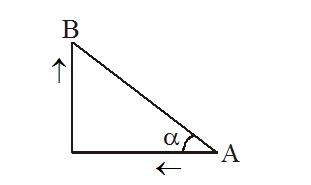
(a) 5.8 m/s
(b) 9.8 m/s
(c) 11.2 m/s
(d) 13.3 m/s
Ans (d)
4.
A monkey is climbing up a tree at a speed of 3 m/s. A dog runs towards the tree with a speed of 4 m/s. What is the relative speed of the dog as seen by the monkey?
(a) >7 m/s
(b) between 5 m/s and 7 m/s
(c) 5 m/s
(d)< 5 m/s
Ans (c)
5.
An elevator, in which a man is standing, is moving upward with a speed of 10 m/s. If the man drops a coin from a height of 2.45 metre, it reaches the floor of the elevator after a time (g=9.8\,\,\mathbf{m/}{{\mathbf{s}}^{\mathbf{2}}}).
(a) \sqrt{2}\,\mathbf{s}
(b) \frac{1}{\sqrt{3}}\,\mathbf{s}
(c) 2 s
(d) \frac{1}{\sqrt{2}}\,\mathbf{s}
Ans (d)
6.
Four persons K, L, M and N are initially at the four corners of a square of side `d’. Each person now move with a uniform speed in such a way that K always headed toward L, L toward M, M toward N and N always headed toward K. After how much time will the four persons meet?
(a) d/v
(b) d/\sqrt{2}v
(c) \sqrt{2}d/v
(d) d/2v
Ans (d)
7.
A glass windscreen whose inclination with the vertical can be changed is mounted on a car. The car moves horizontally with a speed of 2 m/s. At what angle with the vertical should the windscreen be placed so that the raindrops, which are falling vertically downwards with speed 6m/s, strike the windscreen perpendicularly?
(a) {{\tan }^{{-1}}}\frac{1}{3}
(b) {{\tan }^{{-1}}}(3)
(c) {{\cos }^{{-1}}}(3)
(d) {{\cos }^{{-1}}}\frac{1}{3}
Ans (b)
8.
A motorboat covers the distance between two stations on the river t1 = 8h and t2 =12h downstream and upstream respectively. What is the time required for the boat to cover this distance in still water ?
(a) 5.0 h
(b) 2.5 h
(c) 9.6 h
(d) 10 h
Ans (c)
9.
A passenger sitting by the window of a train moving with a velocity v1 = 72 km/h observes for 10 s a train moving with a velocity v2 = 32.4 km/h in the opposite direction. Find the length of the second train.
(a) 290 m
(b) 220 m
(c) 200 m
(d) 250 m
Ans (a)
10.
Raindrops fall vertically at a speed of 20 m/s. At what angle do they fall on the windscreen of a bus moving with a velocity of 54 km/h if the windscreen of the bus is vertical ?
(a) 35°
(b) 33°
(c) 37°
(d) 40°
Ans (c)
11.
Two cyclists move towards each other. The first cyclist, whose initial velocity vo1 = 5.4 km/h, descends the hill, gathering speed with an acceleration a1= 0.2 m/s2. The second cyclist, whose initial velocity vo2= 18 km/h. climbs the hill with an acceleration a2= -0.2 m/s2. How long does it take for the cyclist to meet if the distance x0separating them at the initial instant of time is 195 m ?
(a) 15 s
(b) 30 s
(c) 50 s
(d) 55 s
Ans (b)
12.
A motorboat going downstream overcame a raft at point A; to = 60 minutes later it turned back and after sometime passed the raft at a distance l = 6.0 km from the point A. Find the velocity of the river.
(a) 3 km/h
(b) 8 km/h
(c) 16 km/h
(d) 20 km/h
Ans (a)
Practice Questions (JEE Advance Level)
1.
A car with a vertical wind shield moves along in a rain storm at the speed of 40 km/hr. The rain drops fall vertically with a terminal speed of 20 m/s.The angle with the vertical at which the rain drop strike the wind shield is?
(a) tan–1 (5/9)
(b) tan–1 (9/5)
(c) tan–1 (3/2)
(d) tan–1(c)
Ans (a)
2.
Point A moves uniformly with velocity 5 m/s so that its velocity vector is continually ‘aimed’ at point B which in its turn moves rectilinearly and uniformly with velocity 3 m/s. At the initial moment of time their velocities are perpendicular and the points are separated by a distance of 32 m. Find the time (in second) after which particles will meet.
(a) 20s (b) 10s (c) 5s (d) 2s
Ans (b)
3.
Rain is falling vertically with a speed of 20 ms-1 relative to ground. A person is running in the rain with a velocity of 5 ms-1 and a wind is also blowing with a speed of 15 ms–1 (both towards east). Find the cotangent of the angle with the vertical at which the person should hold his umbrella so that he may not get drenched.
(a) \cot \theta =4
(b) \cot \theta =8
(c) \cot \theta =2
(d) \cot \theta =3
Ans (c)
4.
A glass wind screen whose inclination with the vertical can be changed is mounted on a car. The car moves horizontally with a speed of 2m/s. If the angle of the wind screen with vertical is q when vertically downward falling raindrops with velocity of 6 m/s strikes the screen perpendicularly. Find tan q.
(a) 5
(b)9
(c)3
(d)2
Ans (c)
5.
Two boats were going down stream with different velocities. When one overtook the other, a plastic ball was dropped from one of the boats. Some time later both boats turned back simultaneously & went at the same speeds as before (relative to the water) towards the spot where the ball had been dropped. The boat reaching earlier to the ball will be
(a) the boat which has greater velocity (relative to water)
(b) the boat which has lesser velocity (relative to water)
(c) both will reach the ball simultaneously
(d) cannot be decided unless we know the actual values of the velocities and the time after which they turned around.
Ans (c)
6.
To a man running upwards on the hill, the rain appears to fall vertically downwards with 4m/s. The velocity vector of the man with respect to earth is (2\hat{i}+3\hat{j})m/s. If the man starts running down the hill with the same speed, the relative speed of the rain with respect to man is \sqrt{n}m/s. Find the value of n.
(a)10 (b)20 (c)50 (d)100
Ans (b)
7.
A train passes an observer standing on a platform. The first carriage of the train passes the observer during time t1 = 1s and the second, during time t2 =1.5s. Find the velocity of the train at the beginning and end of observation and its acceleration, assuming that the motion of the train is uniformly variable. The length of each carriage is l = 12 m.
(a) 23.9 m/s; 7.2 m/s; -2.9 m/s2
(b) 13.6 m/s; 5.6 m/s; -3.2 m/s2
(c) 14.8 m/s; 5.6 m/s; -7.4 m/s2
(d) 18.6 m/s; 5.6 m/s; -3.2 m/s2
Ans (b)
8.
A projectile A is projected with a velocity v from the origin at an angle q with x-axis. Another particle B is projected with the same velocity from the position (l, –h, 0) at an angle q with the negative x-axis such that the two particles move towards each other. Find the time after which the separation between the particles is minimum. Also, find the minimum distance between the particles.
(a) t= \frac{\ell }{{2v\,\sin \theta }}\,; Smin = h
(b) t= \frac{\ell }{{4v\,\cos \theta }}\,; Smin = h
(c) t= \frac{\ell }{{2v\,\cos \theta }}\,; Smin = h
(d) t= \frac{\ell }{{2v\,\cot \theta }}\,; Smin = h
Ans (c)
9.
A man in a boat crosses a river from point A. If he rows perpendicular to the banks then he reaches point C after 10 minutes . The point C is lying at a distance x = 120 m downstream from point B. If the man heads at a certain angle q to the straight line AB (AB is perpendicular to the banks) against the current he will reach point B after 12.5 minutes.

(A)
Find the width of the river l
(a) 100 m
(b) 200 m
(c) 400 m
(d) 500 m
Ans (b)
(B)
Find the velocity u of the boat relative to the water
(a) 10 m/min
(b) 5.5 m/min
(c) 0.33 m/s
(d) 0.5 m/s
Ans (c)
(C)
Find the velocity v of river currents.
(a) 1 m/min
(b) 9 m/s
(c) 7 m/min
(d) 0.2 m/s
Ans (d)
10.
Two boats A and B move away from a buoy anchored at the middle of a river along the mutually perpendicular straight lines; the boat A moves along the river, and the boat B moves across the river. Having moved off an equal distance from the buoy the boats returned. Find the ratio of times of motion of boats tA/tB if the velocity of each boat with respect to water is b times greater than the stream velocity .
(a) \frac{\beta }{{\sqrt{{{{\beta }^{3}}\,-3}}}}
(b) \frac{\beta }{{\sqrt{{{{\beta }^{2}}\,-1}}}}
(c) \frac{\beta }{{\sqrt{{{{\beta }^{2}}\,-5}}}}
(d) \frac{\beta }{{\sqrt{{{{\beta }^{8}}\,-1}}}}
Ans (b)
11.
A train of length l = 350 m starts moving rectilinearly with constant acceleration
a = 3 ´ 10-2 m/s2; t = 30 s after the start the locomotive headlight is switched on (event 1), and t = 60 s after that event the tail signal light is switched on (event 2). Find the distance between these events in the reference frames fixed to the train and to the Earth. How and at what constant velocity V relative to the Earth must a certain reference frame K moves for the two events to occur in it at the same point?
(a) 350 m, 242 m, 3.50 m/s
(b) 350 m, 250 m, 4.33 m/s
(c) 350 m, 242 m, 4.33 m/s
(d) 200 m, 242 m, 4.33 m/s
Ans (c)
12.
A car has wind screen in two parts, the lower part is a fixed one and upper part can be opened outwards. Initially both parts are vertical and length of overlapping part is 5 cm as shown in figure. Rain drops are falling vertically with velocity 20 km/h. Car is moving horizontally with velocity 60 km/hr. Find maximum angle through which upper part of wind screen can be opened so that rain drops do not enter the car.

(a) a =50o (approx.)
(b) a =59o (approx.)
(c) a =55o (approx.)
(d) a =52o (approx.)
Ans (b)
13.
The slopes of the windscreen of two motorcars are q1 = 30o and q2 = 15o respectively. At what ratio v1/v2 of the velocities of the cars will their drivers see the hailstones bounced by the windscreen of their cars in the vertical direction? Assume that hailstones fall vertically and collisions are elastic.
(a) 3
(b) 9
(c) 2
(d) 8
Ans (a)
14.
The velocity of water current varies as
v=\left( {\frac{1}{{25}}} \right)y for y£ 250 m
v=20-\left( {\frac{1}{{25}}} \right)y for y> 250 m
where y is the distance from one bank. The width of the river is 500m. A swimmer is crossing the river with constant velocity 5 m/s relative to water and perpendicular to the current. Find the drift of the swimmer.
(a)200 m
(b) 800 m
(c) 500 m
(d) 100 m
Ans (c)
15.
At the initial moment two particles were located at one point and given velocities of 10m/sec each horizontally in opposite directions. If the acceleration due to gravity is g=10m/sec2. Find the distance between the particles at the moment when their velocity vectors become mutually perpendicular.
(a) 40 m
(b) 20 m
(c) 55 m
(d) 15 m
Ans (b)
16.
Two particles, 1 and 2, move with constant velocities v1 and v2 along two mutually perpendicular straight lines toward the intersection point O. At the moment t = 0 the particles were located at the distances l1 and l2 from the point O. How soon will the distance between the particles becomes the smallest? What is it equal to?
(a) t=\frac{{{{v}_{1}}{{l}_{1}}+{{v}_{2}}{{l}_{2}}}}{{v_{1}^{2}+v_{2}^{2}}}, {{l}_{{\min }}}=\frac{{\left| {{{l}_{1}}{{v}_{2}}-{{l}_{2}}{{v}_{1}}} \right|}}{{\sqrt{{v_{1}^{2}+v_{2}^{2}}}}}
(b) t=\frac{{{{v}_{2}}{{l}_{2}}-{{v}_{1}}{{l}_{1}}}}{{v_{1}^{2}-v_{2}^{2}}}, {{l}_{{\min }}}=\frac{{\left| {{{l}_{2}}{{v}_{2}}-{{l}_{1}}{{v}_{1}}} \right|}}{{\sqrt{{v_{1}^{2}+v_{2}^{2}}}}}
(c) t=\frac{{{{v}_{2}}{{l}_{2}}-{{v}_{1}}{{l}_{1}}}}{{v_{2}^{2}-v_{1}^{2}}}, {{l}_{{\min }}}=\frac{{\left| {{{l}_{1}}{{v}_{2}}-{{l}_{2}}{{v}_{1}}} \right|}}{{\sqrt{{v_{1}^{2}-v_{2}^{2}}}}}
(d) t=\frac{{{{v}_{2}}{{l}_{2}}-{{v}_{1}}{{l}_{1}}}}{{v_{2}^{2}+v_{1}^{2}}}, {{l}_{{\min }}}=\frac{{\left| {{{l}_{1}}{{v}_{2}}+{{l}_{2}}{{v}_{1}}} \right|}}{{\sqrt{{v_{1}^{2}-v_{2}^{2}}}}}
Ans (a)
17.
A plane contains two straight lines intersecting each other at an angle a. The lines start moving perpendicular to themselves in the same plane as shown in figure, with velocities v1 and v2 respectively. Then the velocity of the point of intersection of the two lines must be
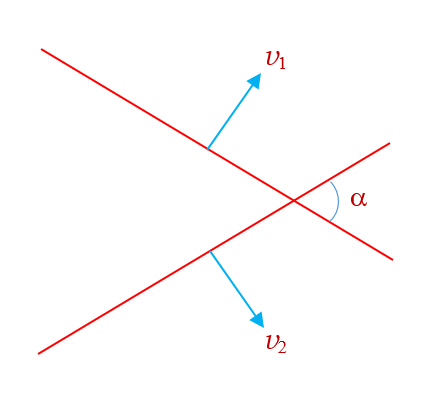
(a) \frac{{\sqrt{{v_{1}^{2}+v_{2}^{2}+2{{v}_{1}}{{v}_{2}}\cos \alpha }}}}{{\sin \alpha }}
(b) \frac{{\sqrt{{v_{1}^{2}-v_{2}^{2}+2{{v}_{1}}{{v}_{2}}\cos \alpha }}}}{{\sin \alpha }}
(c) \frac{{\sqrt{{v_{1}^{2}+v_{2}^{2}-2{{v}_{1}}{{v}_{2}}\cos \alpha }}}}{{\cos \alpha }}
(d) \frac{{\sqrt{{v_{1}^{2}+v_{2}^{2}+2{{v}_{1}}{{v}_{2}}\cos \alpha }}}}{{\cos \alpha }}
Ans (a)

